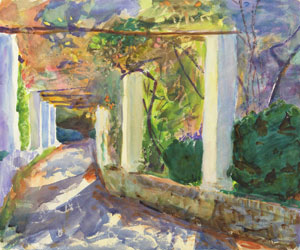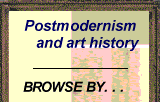Oh, That Colorist
John Haberin New York City
Emily Sargent and Family
John Singer Sargent in Paris
Oh, that one. It could almost be a parody of what you know all too well—the fate of neglected women in the arts. I had lost my way to Emily Sargent and "Portrait of a Family" at the Met. And that, in just three words, is what I heard.
It was a momentary loss, but it was telling. I was in the grand atrium of the American wing, just steps from newly discovered watercolors and a new gift to the Met. And two different guards were ever so helpful and ever so wrong. No, I kept insisting, please, not another wasted walk the length of the museum to the usual blockbuster, John Singer Sargent in Paris. Sure, I kept politely to myself, I know your job is to direct people there, but I mean Emily, his sister, and it is time, her show argues, that we both heard of her. This globe-trotting family would feel at home in Paris, here in New York, or anywhere. 
First, though, a word from a friend about an eminently quotable sitter: she has "the look of experience." Henry James was writing about not Emily Sargent, and a savvy society columnist, but he could just have well have meant the man who painted her, John Singer Sargent in Paris. Each competes for the inside track onto society, high and low. The Met, as the obvious prequel to Emily Sargent and family, tracks the years guaranteeing him a place in both. It shows him still in his twenties but no less sophisticated and already a fixture in demand.
As an added attraction, you get to see two sides to the brother as well. Here he is by Emily's side, devoted to family and where they traveled, almost exclusively in watercolor. And here is in the most cosmopolitan of cities at a time of maximum change in what that means. The portrait of family has an added irony at that: Emily here does not so much as touch portraiture, not even in watercolor. Does this reduce her to a Sunday painter, just when the Met is looking for a major artist? If so, it was a talented one with a gifted teacher.
Brother and sister
If, like the Met's staff, you confuse the two shows, wait till you try to sort out the artists. In a watercolor by Emily Sargent, a house casts the shadow of an improbably glorious afternoon. Its rich blue seems to flow of its own volition from sunlight, the house itself in all its whiteness, and her brush. She might have thrown the pigment down knowing against all reason that it would keep moving across paper until coming to its natural end entirely of its own accord. It brings unmixed colors and scientific precision to the casual flair of high society. In other words, it adapts all the trademarks of John Singer Sargent and then some.
Brother and sister share a space of their own making, in neither realism, Romanticism, Impressionism, or Post-Impressionism, but partaking of them all. Quickly brushed colors punctuate seascapes with people, surf, and smoky shore. Devices like these have set her brother apart from the cutting edge of art history but made him easy to like and a museum staple ever since. Will they do the same now for Emily? A gift of two dozen watercolors, pretty much all from the new century, could count as her own private Modernism. She died in 1936, eleven years past her brother.
She may come as a surprise, but the closeness between the artists should not. Born like John in Florence and barely a year younger, she learned from him, traveled with him, and worked beside him—at times on the same sheet. Far from trying to discourage her painting, he offered advice on it, marking up a work in progress. They visited the Alps, Spain, northern Italy, and the Holy Land together, to the classiest and most picturesque of lakes, gardens, palaces, and mansions. John painted her at work and introduced her to erudite and creative friends. The Met showed him in good company just ten years ago.
Emily and John could claim an entire family of artists as well, and the show includes work from them all. Their mother, Mary, a more conservative painter, promoted their career without giving up hers. Their father, FitzWilliam, a surgeon who gave up his career in Philadelphia for life on the move, could not help taking a sketchbook along. Their younger sister, Violet, made accomplished pencil sketches years later while managing John's estate. Whatever, then, happened to Emily? It may not be what you think.
No question a family then would have favored an older male over his sister. A small show is smaller still when you consider that John found time for two thousand watercolors—a subject for the Brooklyn Museum in 2013. A male, too, would have found a ready market, especially one with a gift for portraiture and provocation, and who was she to complain? They were out to enable a legacy, by any means possible. This was family as corporate entity—a corporation with a love of art.
Emily had her limits, too. John had an eye for people and particulars, from children to Madame X, that changes what one sees in his still life and landscapes as well. He also knew a greater restraint, so that white space becomes color and quantity gives way to intensity. And yet she literally outlived him, approaching abstraction as her brother never could. When red and blue-green bring subject and shadow into the picture plane, you can see a common style once again. You can also see the future.
Society high and low
Sargent's woman in Paris was, James wrote, "a masterly rendering," but you may remember a very different artistry. Emma Allouard-Jouan, a close friend of Sargent's, is "slightly faded and eminently sensitive and distinguished." Who knew that those terms all go together, and who associates them with so flashy a painter? Or does his surface flash always comport with something more? Only her face with its deeply shaded eyes emerges out of the darkness. She looks not so much worn as sober, with a working woman's clothes, a journalist's keen eye, and the elusive setting for a life.
 Sargent arrived in Paris at just eighteen, in 1874, and you may think you know the story of an American in Paris well. Raw talent learns from his European betters, generous in their encouragement and unforgiving in their criticism. Sargent had particular luck in a mentor, the self-styled Carolus-Duran, who insisted on the study of Diego Velázquez. It taught Sargent minimal underpaint, near photorealism in charcoal, and commitment to portraits in the company of artists, writers, gentlemen, and kings. A less talented student would have floundered in the face of so many irreconcilable demands. Instead, it kept his mind open to the fitful pursuit of modern art.
Sargent arrived in Paris at just eighteen, in 1874, and you may think you know the story of an American in Paris well. Raw talent learns from his European betters, generous in their encouragement and unforgiving in their criticism. Sargent had particular luck in a mentor, the self-styled Carolus-Duran, who insisted on the study of Diego Velázquez. It taught Sargent minimal underpaint, near photorealism in charcoal, and commitment to portraits in the company of artists, writers, gentlemen, and kings. A less talented student would have floundered in the face of so many irreconcilable demands. Instead, it kept his mind open to the fitful pursuit of modern art.
Sargent could never quite embrace Impressionism or a newer art. He was born too soon and to all the right people, and he never did fit my tidy story. Raised in Florence to American parents, he came to Paris a seasoned traveler. Even so, he could hardly stay put. The curators, led by Stephanie L. Herdrich, take him to northern and southern France, Naples and Capri, Morocco, Boston, and beyond. His languid male models may leave one as uncertain about his longings in another way as well.
But then there are more than enough versions of John Singer Sargent to go around. If those versions include classical technique, racy women and child portraits, and fashion, all the better for him. It has given him New York shows of charcoals, caricatures, the artist's creative circle, landscapes, and the influence of Spain—all within the time of this Web site. Excuse me if I largely leave you to past reviews for more. This artist who would try anything once and comport with anyone. And then he kept looking.
There is no explaining sheer talent, but good art should have you thinking about something else—just what he was doing. The son of a surgeon who chose to remain abroad, he had that rare combination of intellect, feeling, questioning, and detachment. A room at the Met for half a dozen contemporary artists helps, too, by focusing on differences. If you want a true Edwardian reformer, try James McNeill Whistler, but if you want the shock of the new, try Edouard Manet. If you want a science of vision guiding seemingly free brushwork, try Claude Monet. If you want a close copy after Velázquez, Sargent can supply one, but he will be sure that you see it as a quick copy.
He did not ask for outrage at his near strapless portrait of Madame X, but he got it, and it drove him to leave Paris for one last move, to London. It should make you think again, too, about the flash. Fashion for Sargent opens onto psychological depths otherwise unseen. A commanding red robe somehow pops out from an equally red curtain, because people here are only partly in command. A brother and sister share everything but their degree of confidence and uncertainty, while four sisters move through a room of vases as tall and as seemingly human as they. But then what is it to be sophisticated, apart from money, and what is it to be human?

Emily Sargent and family ran at The Metropolitan Museum of Art through March 8, 2026, "John Singer Sargent and Paris" through August 3, 2025. I have so many related reviews of Sargent and his work that I shall leave links to the text.




